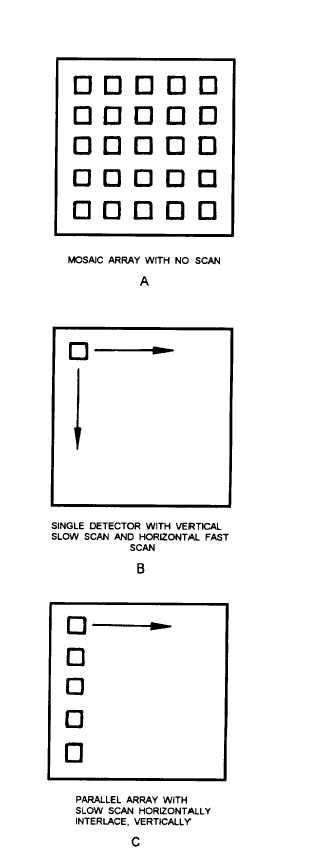achieve maximum resolution. A large number of
detector elements can be grouped together to form an
array (fig. 6-8, view A). The elements of this array
are packed closely together in a regular pattern. Thus,
the image of the scene is spread across the array like a
picture or a mosaic. Each detector element views a
small portion of the total scene. The disadvantage of
this type of system is that each detector element
requires a supporting electronic circuit to process the
information that it provides. Also, each detector
element requires a preamplifier to boost the signal to
a usable level.
SINGLE DETECTOR.— Another method that is
used to provide the operator with information is the
single detector (fig. 6-8, view B). Here, there is one
detector requiring one set of supporting circuitry. In
this type of system, the detector is scanned across the
image so that the detector can see the whole image.
An optical system is required that can supply the
scanning. This type of system is adequate if real-time
information is not needed, or if the object of interest is
stationary or not moving quickly.
Scene Dissection System
The scene dissection system is used to scan the
scene image. There are many types of scanning-one
associated with each type of detector array. When a
single detector with one axis of fast scan and one axis
of slow scan is used, the scene is scanned rapidly in
the horizontal direction and slowly in the vertical
direction. As a result, the line is scanned horizontally;
then the next line is scanned horizontally, etc.
A vertical linear array is scanned rapidly in the
horizontal direction (fig. 6-8, view C). One
detector element scans one line of the image. In the
linear array, there is a space, one element wide,
between each element. The scan is one axis with an
interlace being used.
A vertical linear array is
scanned rapidly in the horizontal direction. After
each horizontal scan, the mechanism shifts the
image upward or downward one detector element
width so that on the next scan, the lines that were
missed are covered.
Each system has an optimum configuration of
detector array and image dissection. If the number of
elements in the detector increases, the system
becomes more complicated. Also, the cost of the
Figure 6-8.-Detector arrays.
6-6


